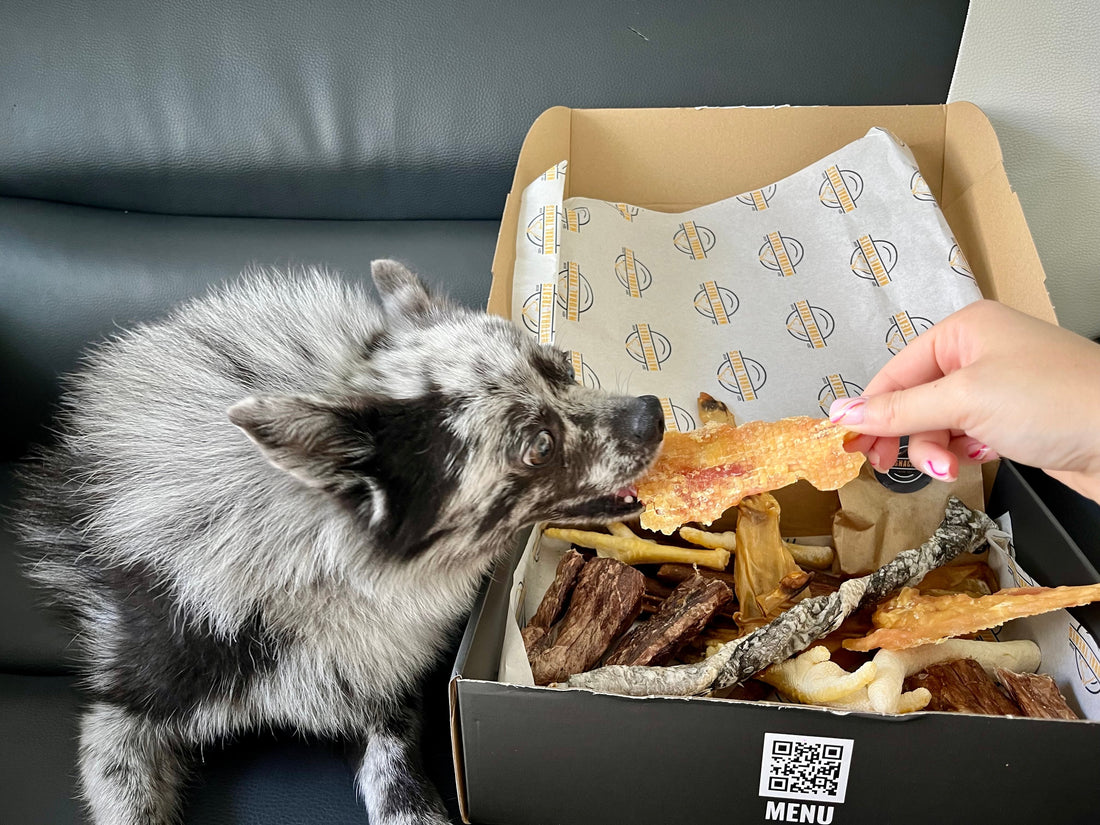Grain-free dog treats have really caught on with pet owners who want healthier options for their pups. Instead of using cereals like wheat, corn, or barley, these treats rely on single ingredients such as fish, duck and lamb. If your dog has a sensitive stomach or special dietary needs, grain-free treats might just be the way to go.
Grain-free dog treats can help dogs with food sensitivities by providing high-quality protein and essential nutrients without common allergens. Just because they skip the grains doesn’t mean they lack nutrition—ingredients like fish and lamb keep things balanced and wholesome.

If you want treats that actually benefit your dog, you’ve got to look past the grain-free label. The best options use quality ingredients, get the nutrition right, and follow strict manufacturing standards for safety and digestibility. Whether you’re training, rewarding, or helping with dental care, picking the right grain-free treats can make a real difference in your dog’s wellbeing—and, honestly, most dogs seem to love the taste.
Key Takeaways
- Grain-free dog treats use alternative carbs and focus on real, high-quality protein.
- They’re ideal for dogs with sensitivities or allergies to common grains.
- Top-notch grain-free treats offer complete nutrition with natural ingredients like fish, lamb, and real meat with no fillers.
What Makes A Dog Treat Hypoallergenic
Hypoallergenic dog treats use ingredients that rarely trigger allergies in sensitive pups. The focus is on simple, limited recipes—nothing too complicated.

Novel Proteins are the backbone of most hypoallergenic treats. Think proteins your dog hasn’t tried before, like:
- Duck
- Lamb
- Salmon
- Venison
- Turkey
We don’t include common allergens like beef and chicken in these.
Limited Ingredient Lists make it easier to spot any triggers. The fewer the ingredients, the simpler it is to figure out what’s causing issues. Most hypoallergenic treats stick to five ingredients or less. Most of our natural dog treats contain only one ingredient.
Grain-Free Carbohydrates replace wheat, corn, and soy. Sweet potatoes, green peas, and chickpea flour are all safe bets—they’re easier on digestion and less likely to cause trouble.
Natural Preservation really matters. Artificial preservatives can set off allergies in some dogs. We prefer treats preserved with vitamin E or rosemary extract over synthetic stuff.
Processing Methods also play a role. Some treats use hydrolysed proteins—basically, the proteins get broken down into smaller bits so the immune system doesn’t recognise them as allergens as easily.
Cross-contamination prevention during manufacturing is key. If a facility handles multiple protein sources, there’s a risk of mixing allergens into treats that are supposed to be safe.
We skip artificial colours, flavours, and fillers too—keeping it simple and whole-food based is safest for dogs with sensitivities.
Practical Tips For Dogs With Allergies
Spot the warning signs early so you can help your dog feel better. If your dog’s itching, scratching, licking, or rubbing their face, that’s a red flag.

Red skin and fur loss can also show up. Sometimes allergies cause ear infections or tummy trouble too.
Keep a food diary when you try new treats. Note what your dog eats and any reactions—it makes finding the culprit way easier.
Read ingredient labels carefully before you buy. Steer clear of common allergens like:
- Wheat and corn
- Soy products
- Dairy items
- Artificial additives
Start with single-ingredient dog treats if you’re testing for allergies. Sweet potato chips or freeze-dried chicken are great for this.
Choose novel proteins if your dog’s got multiple allergies. Venison, duck, or fish might be safer than the usual meats.
Make homemade treats if you want total control over what goes in. Try simple recipes with coconut flour, pumpkin, or rice flour as the base.
Introduce new treats slowly—just a little at first. Watch for any reactions over the next day or two before giving more.
Work with your vet if allergies are really severe. They can help you create an elimination diet and point out ingredients to avoid.
Store grain-free treats properly in airtight containers. Homemade ones usually last 3–5 days in the fridge, or you can freeze them for later.
Always check with your vet before making major diet changes, especially if your dog’s got other health stuff going on.
Best grain-free natural dog treats
Single-ingredient natural treats are about as pure as it gets—no grains, no artificial anything. They come straight from animal parts and give dogs a great chewing experience.
Ears make brilliant natural treats for all sizes. Pig ears are a hit with medium and large breeds, while rabbit ears are just right for smaller dogs. Cow ears land somewhere in the middle and give a satisfying chew.

Tough chews like yak sticks keep power chewers busy for ages. These hard treats help clean teeth naturally as your dog gnaws away. Bull pizzles work similarly with a chewy texture dogs love.

Poultry options like chicken feet and duck necks are great too if your dog can eat poultry. Chicken feet offer natural glucosamine for joints, and duck necks give a more substantial chew for medium dogs.

Larger cuts are perfect for big breeds. Lamb legs last for hours and beef tails are packed with flavour—dogs go nuts for them.

| Treat Type | Best For | Benefits |
|---|---|---|
| Rabbit ears | Small dogs | Gentle, digestible |
| Pig ears | Large dogs | Long-lasting chew |
| Yak sticks | Power chewers | Dental health |
| Chicken feet | All sizes | Joint support |
| Lamb legs | Large breeds | High protein |
At Natora, we offer natural treat boxes with a variety of grain-free options. They’re perfect if you want to let your dog try different treats without committing to big bags of each.

Our natural dental sticks, made from dried meat, clean teeth without any grains or chemicals.

Frequently Asked Questions
We hear a lot of questions about grain-free treats and how they affect dogs. Most of the time, people ask about allergies, safety, ingredients, and how to switch treats without causing problems.
What are the benefits of feeding my dog treats without grains?
Grain-free treats can make digestion easier for dogs with sensitive stomachs. They skip common allergens like wheat, corn, and soy, which sometimes irritate the gut.
They’re usually lower in carbs, so they work for dogs who need to watch their weight.
Most grain-free treats use better protein sources and may include things like probiotics or omega-3s, which are great extras.
Dogs with grain issues often show better skin and coat health, and their digestion tends to improve too.
Can grain-free treats help with my dog's allergies?
Grain-free treats can help dogs with food allergies by cutting out big triggers. Wheat, corn, and soy are behind a lot of allergic reactions.
Some dogs with skin problems also do better on grain-free diets. Grains sometimes make skin conditions worse.
Limited-ingredient, grain-free treats are especially helpful for sensitive dogs since there are fewer possible allergens.
But not every allergy is grain-related. Sometimes the real problem is a protein or another ingredient.
Are there any risks associated with grain-free diets for dogs?
Some dogs get a bit of digestive upset when you first switch to grain-free treats. Go slow to avoid this.
There’s been some buzz about grain-free diets and dilated cardiomyopathy (DCM) in certain breeds—a heart muscle issue. It’s something to keep in mind.
Not every dog needs a grain-free diet. Plenty of dogs handle grains just fine.
Grain-free treats do tend to cost more, so weigh the benefits for your dog.
What alternative ingredients are commonly used in grain-free dog treats?
We use sweet potatoes and chickpeas a lot as grain substitutes. They add carbs and fibre for energy and digestion.
Novel proteins like venison, duck, and rabbit show up in many of our grain-free treats—great for dogs with protein allergies.
Almond flour and coconut flour often take the place of wheat flour. They bring in protein and healthy fats.
We sometimes add probiotics and antioxidants for immune support and overall health.
How do I transition my pet to a grain-free treat regimen safely?
Start slow—give your dog just a little bit of grain-free treats at first, maybe 25% of their usual treat portion.
Increase gradually over a week or so, and keep an eye out for any digestive changes or odd behaviour.
Watch your dog closely during the switch. Look for better digestion or skin health, but also keep an eye out for any problems.
Check in with your vet before you make big diet changes, especially if your dog has health issues. At Natora, we're always happy to help answer your questions about our products too.
What should I look for when choosing a grain-free treat for my dog?
Start by checking the ingredient list—go for treats packed with real, recognisable foods. Skip anything with artificial additives or odd fillers. Nobody wants that in their pup’s snack.
Make sure the first ingredient is a quality protein source. That’s usually a good sign you’re getting something worthwhile.
Pick treats that match your dog’s age and size. Puppies and seniors just don’t have the same needs, so it matters.
If your dog deals with allergies or sensitivities, limited ingredient treats are usually a smart bet. At Natora, we’ve got a solid selection of these grain-free treats, so you can find something that actually works for your dog.




